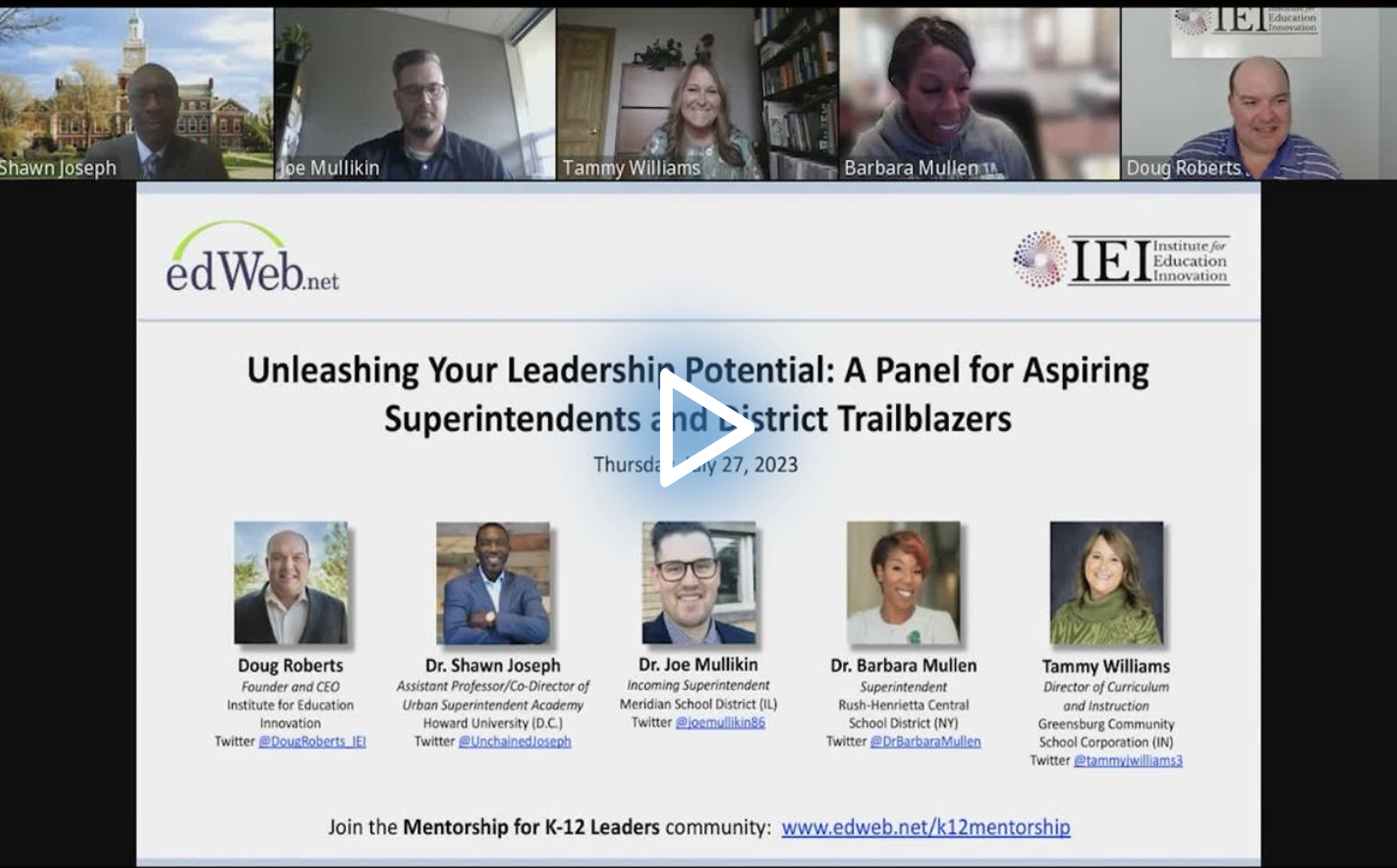Unleashing Your Leadership Potential
Watch the RecordingListen to the Podcast
For the last decade, school districts have been struggling with teacher attrition rates, as the average “burnout” rate for incoming teachers has been approximately five to seven years. While state and local education agencies have been working on various strategies to get more teachers in the classroom, a new crisis has emerged: attrition in educational leadership.
The stresses of the pandemic gave way to hostile culture wars that placed many superintendents and top-level administrators directly in the crosshairs of a perfect maelstrom that has led many to retire early or leave the public education sector.
Organizations like the Institute for Education Innovation (IEI) are working hard to reverse this trend through their IEI Lead initiative, which is designed to help mentor and coach the next generation of educational leaders.
During the edLeader Panel “Unleashing Your Leadership Potential: A Panel for Aspiring Superintendents and District Trailblazers,” accomplished leaders shared how to unleash and develop the necessary skills to navigate today’s chaotic waters of educational leadership.
Educational Leadership and Community Representation
The PreK-12 educational workforce is as diverse as it has ever been. However, this diversity has not followed through to the top levels. According to Dr. Shawn Joseph, Assistant Professor and Co-Director of the Urban Superintendent Academy at Howard University, student demographics and educational leadership are far from alignment.
For women, there is also a large gap, as 80% of the educator workforce is comprised of women, but only 24% of superintendencies are occupied by women. Dr. Joseph explains that the lopsided nature of these demographics is a problem because study after study has shown that students with leadership who represent them tend to do better academically because they see, in a real person, an example of someone who looks like them and has achieved success.
In addition to the demographical challenges, Dr. Joseph points out that the job of a superintendent is tough. Statistics show that the average tenure of a non-urban superintendent is about six years, for an urban superintendent that drops to three years, and for a person of color in the superintendency, it’s a little over a year.
Creating an Ecosystem for Education Leaders
While these statistics may seem daunting, there is good news. A growing number of organizations are creating or have already created Aspiring Superintendent programs, like the American Association of School Administrators (AASA), the Association of Latino Administrators and Superintendents (ALAS), and the Institute for Education Innovation, through its IEI Lead initiative.
Dr. Joseph stated, “No superintendent can survive the tumultuous nature of the political landscape nowadays without support. And it’s a multitude of support that’s needed for managing the politics to actually having an impact on the work.” And this is where he says organizations like IEI can play a vital role because they “can really play a role in the support because you have to create an ecosystem.”
Realizing Your Leadership Potential
The superintendents on the panel began their journeys in education as most superintendents do—as classroom teachers—yet each has had a very different path to leadership.
For incoming Meridian School District (IL) superintendent Dr. Joe Mullikin, administrative leadership was the furthest thing from his mind when he began his career as a high school science teacher. He joked that as a student he “didn’t have a good relationship with [administrators] in school and I wasn’t going to go down that path.”
However, that all changed when he met Dr. PJ Caposey, the outgoing superintendent for Meridian. He said that Dr. Caposey saw the potential in him that he couldn’t see in himself. Having someone mentor him and communicate the positives to him was career changing, and so he began to strive for leadership roles in the school building that ultimately led to opportunities at the district level.
Dr. Barbara Mullen, the incoming superintendent of Rush-Henrietta Central School District (NY), shared that since childhood she had considered herself a leader, but that realization was confirmed when she became a special education teacher.
Even though every teacher is a leader in the classroom, she says that special education teachers are thrust into leadership on day one because “other people are looking at you to tell them how to the support the student(s) on their caseload because…people feel very insecure around their ability to support and educate students who are diverse learners, and so they’re often looking at the special educator, whether it’s the classroom teacher, the clinician, the coordinator, the special ed director.”
It became apparent very early on in her education career that she had to be the voice and advocate for her students, which meant she had to lead the adults around her to ensure they received the services and attention they needed to succeed.
For Tammy Williams, the Director of Curriculum and Instruction at Greensburg Community School Corporation (IN), her experience as a classroom teacher led her to embrace bigger leadership challenges. As a teacher, her goal was to impact the 25 students in her classroom. Upon reflection, she realized she was not only impacting them, but their families too—if she could have this big of an impact at the classroom level, she wondered how much bigger of an impact she could have on the whole building, which led her to pursue bigger leadership opportunities.
Identifying and Overcoming Leadership Obstacles and Barriers
Every leadership journey has a specific path with its own unique set of obstacles and barriers. However, there are common threads that can be identified and addressed to overcome those challenges:
- Understanding your role: In the moment, what is your role? What are you being called to do? How do you leverage your skill set and expertise to accomplish the goal?
- Identify the expert: Recognize that you cannot possibly be the expert in every area and know when to find the right people, at the right time, to help you. The old adage, “A Jack of all trades is a master of none,” is an adage for a reason.
- Every route to the top is different: Many superintendents begin their leadership journey as school principals. While not having served in this role can be viewed as an obstacle, know that there are other paths to the top. Promote your unique accomplishments and how you have worked with different leadership styles and school cultures.
- Leadership requires coaching: As a leader, a primary role is to encourage, coach, and support those around you so that kids have the greatest opportunities. When the kids succeed, the school and district succeed.
Be True to Yourself: Find the Right Fit
A current theme throughout the edLeader Panel was the importance of “fit.” Finding the right fit on a personal leadership journey is a key factor for success. The right fit might entail ensuring alignment with a district’s vision, mission, and priorities. It may mean understanding the “politics” (with a little “p”) of how a system works and whether you are comfortable within that system.
Knowing how to align yourself with systems of support within a district is critical to navigating the system. Is the school board supportive? Is the broader community supportive? Is it the right time to move to that particular leadership role? If it is not the right fit, be true to yourself and find the right opportunity at the right time.
Great Mentors Grow Great Leaders
The panelists agreed that seeking out mentors is essential for leadership growth. Each shared short stories about personal mentors as well as role models they have followed on the larger stage. As they shared information about their specific mentors, a great picture of diversity emerged, as each of the panelists had mentors who varied in background—from different leadership roles within a district or school to different ethnicities and genders. Great mentors can come from any background—it is the wisdom, expertise, and time they are willing to share that is so valuable.
Dr. Mullen stated, “Time is money, and so when people who make a living coaching, consulting, and mentoring answer the phone for free for you, those are the type of people who not only do I say okay, thank you for pouring into me, but I also know that now I have a responsibility to do the same thing and pick up the phone.”
The mentorship discussion ultimately led back to the beginning of the conversation and the importance of having organizations and initiatives like IEI Lead that are committed to working with the next generation of school leaders to ensure they have the networks, mentors, support, and community they need to lead successful school districts where students achieve and thrive academically and in life.
Learn more about this edWeb broadcast, Unleashing Your Leadership Potential: A Panel for Aspiring Superintendents and District Trailblazers, sponsored by Institute for Education Innovation.
Watch the RecordingListen to the Podcast
Join the Community
Mentorship for K-12 Leaders is a free professional learning community that aims to connect aspiring leaders with mentors and content that helps guide, support, and provide insights into education leadership.
The Institute for Education Innovation is bridging the gaps between the individuals and organizations committed to seeing students succeed in school and life, creating a safe space for constructive problem-solving and innovative thinking.
Blog post by Ginny Kirkland, based on this edLeader Panel






Comments are closed.